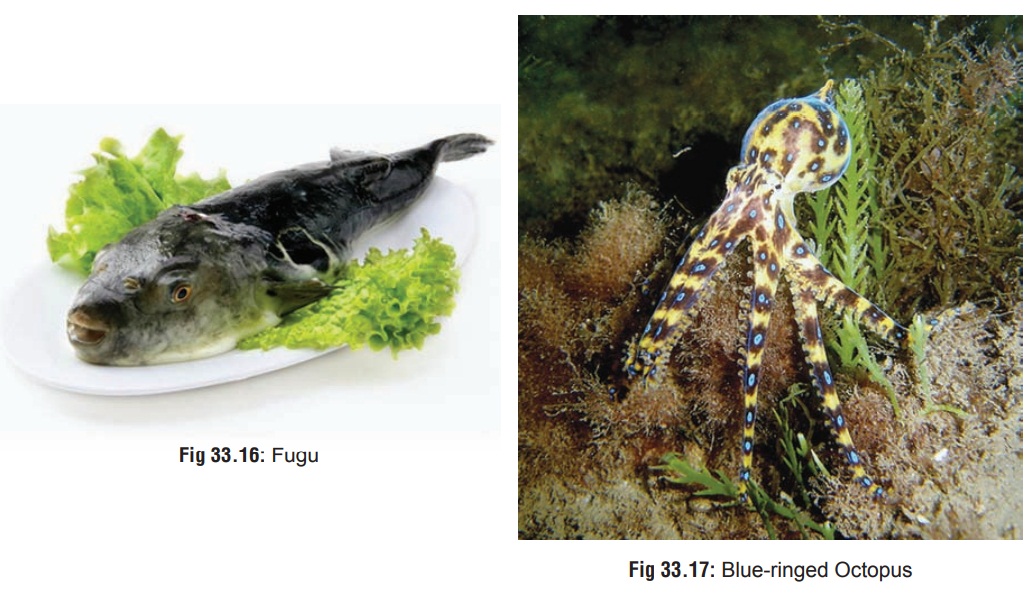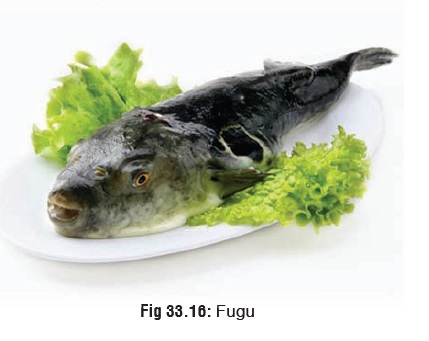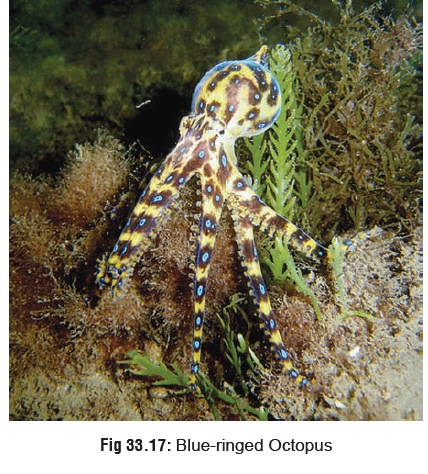Chapter: Modern Medical Toxicology: Food Poisons: Food Poisoning
Tetrodotoxic Poisoning

Tetrodotoxic Poisoning
Source
·
Puffer fish: globe fish, balloon fish,
blowfish, toad fish. In Japan, a variety of puffer fish called “fugu” (Fig 33.16) is considered a delicacy,
but special licensing is required to prepare this extremely toxic fish.

·
Newts: taricha, notophthalmus,
triturus, cynops. Salamanders.
·
Blue-ringed octopus (Hapalochlaena maculosa) (Fig 33.17): of Australia and Japan is
the only known species in which tetrodotoxin has been found in extracts of
venom glands, in contrast to being found in the skin, muscle, liver, ovaries,
and eggs of other species.

·
Snails: In a study of several
outbreaks of tetrodotoxin- associated snail poisoning in Zhoushan city, China,
the following snail species were identified as culprits: Zeuxis samiplicutus, Zeuxis siguinjorensis, Zeuxis variciterus, and
Z. succinctus. In all the cases, the
snails were steamed, boiled, or fried. The incubation period ranged from 5
minutes to 11 hours, and the time from a patient’s inges-tion of snails to full
recovery ranged from 30 minutes to 48 hours.
·
Horseshoe crab eggs.
Toxin
Tetrodotoxin
(TTX) is a potent, heat-stable, water soluble, non-protein
aminoperhydroquanizole neurotoxin concen-trated mainly in the skin, liver,
ovary, and intestine of the fish. The highest concentration is found in the
ovaries, and hence the female is most poisonous, especially if eaten during the
spawning season.
Mode of Action
Tetrodotoxin affects myelinated nerve fibres throughout the entire length of the axon by lowering the conduction of sodium currents at nodes of Ranvier. It is a selective and potent sodium channel blocker. TTX blocks the action potential without any effect on resting membrane potential, or the resting membrane resistance.
It blocks nerve and
muscle conduction. Its action is thought to interfere with the increase in
sodium permeability associated with nerve excitation, with changing potassium
permeability.
Incubation Period
Onset
is usually within 4 to 6 hours, but may be delayed. Oral paraesthesia is
usually the initial symptom of puffer fish poisoning. Death may occur within
the first 6 to 24 hours. Prognosis is good if the patient survives the first 24
hours.
Clinical Features
·
Poisoning is caused by ingestion of
the flesh, viscera, ovaries, or skin containing tetrodotoxin (TTX). The highest
concentration is in the viscera. Body musculature is usually free of poison.
·
Main features of poisoning include
headache, sweating, dysaesthesias, and paraesthesias of lips, tongue, mouth,
face, fingers, and toes. Circumoral tingling may include the tongue and inner
surface of the mouth, and generally occurs within 10 to 45 minutes of
ingestion.
·
Later, the following are seen:
salivation, dysphagia, dysar- thria, nausea, vomiting, abdominal pain, ataxia,
weakness, fasciculations, and ascending paralysis in 4 to 24 hours.
·
Blurred vision, aphonia, and
dysphagia may be seen as muscle paralysis progresses. Miosis is an early effect
of TTX poisoning, but later there is mydriasis.
·
Hypotension, bradycardia, and fixed
and dilated pupils indicate severe poisoning. Mortality may approach 50%. Death
is usually due to respiratory depression and respira- tory muscle paralysis.
·
Some cases of seizures have been
reported in TTX poison-ings. If at all they occur, seizures generally manifest
only in the course of severe TTX poisonings
·
A rare “locked-in” syndrome has been
described with tetro- dotoxic poisoning, in which the patient appears
completely flaccid, but remains conscious.
Diagnosis
·
Mouse bioassay: Laboratory determination
of tetrodotoxin (TTX) is not commonly available. Potency of TTX must be done by
bioassay; identification may be done with thin layer chromatography.
·
Fluorescent spectrometry.
·
Use of electrophoresis, HPLC, LC/MS,
etc., have also been reported by various investigators. A relatively new
immunoassay method, using a highly specific monoclonal antibody (MAb) and
immunoaffinity column chromatog- raphy, has recently been developed for the
isolation and identification of TTX from urine samples of poisoned patients.
This method is performed in combination with fluorometric HPLC.
Treatment
Because
of the differences in susceptibility, and unpredictability of an individual’s
course, at least 24 hours of observation is recommended in every patient.
·
Decontamination: Activated charcoal
may be useful.
·
IV edrophonium (10 mg) or IM
neostigmine (0.5 mg) may be effective in restoring motor strength.
·
Artificial ventilation should be
implemented if necessary.
·
Assisted ventilation may be
necessary for 4 to 6 hours, and in some cases up to 12 hours.
·
Haemodialysis may be effective in
the treatment of tetro-dotoxin poisoning, because the toxin has low molecular
weight, is water soluble, and is not significantly bound to protein.
Related Topics